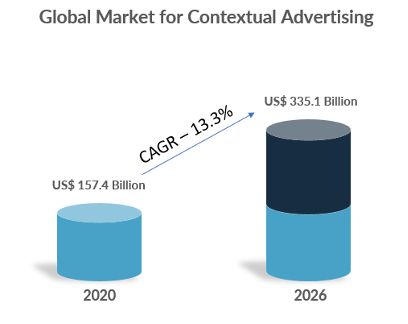
Impact of Privacy Policy Changes on the Advertising Industry
As privacy changes loom, the advertising sector is expected to undergo fundamental changes. The privacy-centric policies are impacting advertisers by depriving them of customer data needed to optimize ads. As a result, marketers are re-envisioning their strategies to stay ahead of the curve. This is expected in the emergence of new trends in the advertisement space, such as an increased focus on cookie-free start-ups, the growing importance of first-party data, increased penetration of AI/ML & data science in advertising, the emergence of server-to-server fingerprinting, and a resurgence of contextual targeting.
The rising concerns around data collection and privacy have caused governments and corporations to bring changes to data privacy policies. According to a survey from consent experience platform Qonsent, 94% of respondents felt the need for more transparency about their digital data. Apple implemented changes to its privacy policy in 2021 by unveiling the App Tracking Transparency (ATT) feature that restricts advertisers from accessing an iPhone user identifier, ultimately reducing their targeting capabilities. Google plans to phase third-party cookies out of its Chrome browser by 2024. The changes from both companies affect companies like Meta, which rely heavily on third-party data tracking users across apps.
Fig 1: Concerns Around Data Privacy are on the Rise

Source: Qonsent
Fig 2: A Timeline of Privacy Policy Changes

Source: Accuracast
State of Privacy Laws in the US and Globally
Governments worldwide are increasingly bringing in regulations to protect consumer privacy and data. According to the United Nations Conference on Trade and Development, 137 countries have legislations to secure data protection and privacy. Europe’s General Data Protection Regulation – one of the strictest data privacy and security laws – applies to companies operating in the EU and outside the EU targeting/collecting data related to EU residents.
Fig 3: Data Protection and Privacy Legislation Worldwide

Source: UNCTAD
The US is quickly catching up with the EU in implementing data privacy regulations. California became the first state to bring privacy legislation when California Consumer Privacy Act went into effect in 2020. It was followed by Virginia’s Consumer Data Protection Act (March 2021), Colorado’s Colorado Privacy Act (July 2021), and Utah Consumer Privacy Act. Other US states such as Nevada, Connecticut, and Vermont have enacted comprehensive consumer data privacy laws or are in the process of doing so. In June 2022, lawmakers introduced the American Data Privacy and Protection Act, the first comprehensive national data privacy framework.
Impact of Privacy Policy Changes on Advertisers
Whether by corporations or governments, the push toward improved data privacy is causing a significant shift in digital advertising, forcing advertising-driven companies to change business models. As businesses find it hard to track activities on the apps and websites, they risk losing valuable insights for targeting potential customers. This also means added costs for marketing activities. According to Meta, failing the ability to track conversions and returning to click optimization links could lead to significantly higher prices – up to a 150% average increase in cost-per-action. Similarly, data from mobile marketing platform Singular suggests that Apple’s privacy changes led to a 40% reduction in the average mobile advertiser’s ROI and a 25% drop in mobile ad spend. As marketers try to adjust to the new changes in privacy, they still need to change their approach to digital advertising.
Fig 4: Apple’s Privacy Changes Lead to Drop in Ad ROI and Spending

Source: Singular (Mobile Marketing Platform)
The Spotlight will be on Cookie-Free Ad-Tech Start-Ups.
Microsoft, Apple, and Google’s disruptive decision to ban cookies have brought cookie-free ad-tech start-ups into the limelight. These emerging start-ups are well-poised to fill the gap for innovative advertising solutions which can work without relying on cookies. These companies can carve out a niche in the $400 billion digital advertising space with their innovative technology. One such company Seedtag, which recently raised a $250+ million funding round, has developed contextual AI technology to replace cookies. The company reads what’s on a webpage rather than tracking browsing user’s history. The technology combines that learning with its algorithm to understand users’ interests.
Additionally, ad tech company The Trade Desk has developed Unified ID 2.0, an open-source framework built from hashed and encrypted email addresses that publishers, advertisers, and digital advertising platforms can use to establish identity without third-party cookies. With their ability to enable businesses to serve ads in relevant places on programmatic platforms, these companies will have a competitive edge over their peers in a cookie-free world.
Fig 5: Unified Id 2.0

Source: Above the Fold (Digital Marketing Agency)
First-Party Data from Consenting Users Will Become Increasingly Important
The restricted access to third-party data has put marketers in a tough spot, requiring them to build robust and effective first-party data collection strategies. First-party data – the data from brands from customer activity on their website and apps – usually come from multiple touch points, including offline, digital, websites, apps, and social. Key advantages include increased compliance with privacy regulations, more data collection and usage transparency, and increased customer trust. Coming directly from the customer, the first-party data is more accurate and helps improve margins. According to a BCG and Google study, using first-party data for crucial marketing initiatives saw up to 2.9 times more revenue (compared to companies that didn’t) and 1.5 times fewer costs.
Fig 6: First Party Data Leads to Higher Revenue and Lower Cost

Source: BCG Digital Marketing Maturity study 2019, Asia Pacific brands
Around 37% of businesses currently use first-party data to offer their customers a customized experience, which is expected to go up as privacy regulations pace. This is also likely to result in more brand ad-tech investment, supporting the growth of customer data platforms such as Rudderstack and Segment. These platforms offer technical capabilities for collecting first-party interactions throughout the customer journey and help integrate that data into the marketing and analytics tools for improved customer experiences.
Increasing Penetration of AI & ML, and Advanced Data Science and Modeling
AI and ML have matured since ad tech’s early days and are expected to play an essential role in the privacy-centric advertisement landscape. Implementing AI & ML allows marketers to place hyper-relevant ads without requiring personally identifiable information. With the new policy changes reducing the volume of customer data, AI can play a significant role in the transition from volume to predictive capabilities by allowing algorithms to get insights from fewer volumes of data.
The privacy changes by Apple have affected marketers’ ability to measure ad effectiveness while reducing the volume of post-ad-click conversion data. Companies like Singular offer innovative solutions to overcome this constraint. Its solution, called SKAN Advanced Analytics, uses advanced data science, modeling, and ML to provide estimates for essential metrics like cohorts, ROI, and lifetime value of new customers and help marketers run high-performance and privacy-safe user acquisition campaigns on iOS.
In another testament to ML’s growing role in advertising, Google updated its ad attribution model last year to offer marketers more accurate, precise, and privacy-centric measurements. The new model will see Google Ads employing ML instead of consumers’ last interaction to assess data from throughout the conversion pipeline.
Fig 7: Role of AI & ML in Digital Advertising

Source: SmartyAds
Rise of Server-to-Server Fingerprinting
Apple’s ATT privacy policy has upended the digital advertising space. With Apple making explicit user consent mandatory for tracking activity and data collection, server-to-server fingerprinting is rising as developers use a harder-to-track version of fingerprinting to sidestep Apple’s policies. This technique (1) blurs the line between legitimate and banned data requests – replicating IDFA tracking functionality – and (2) allows for user identification only when the data crosses over to the remote server, beyond Apple’s purview. Apple can see the information apps pass back to servers but can’t do anything about it as this information is also helpful for other app functions and doesn’t violate Apple’s terms. While the apps using device fingerprinting run the risk of getting banned by Apple, the practice is increasingly common due to most users opting out.
Contextual Advertising to Make a Comeback
As the advertisement industry grapples with the consequences of privacy policy changes, contextual advertising is seeing a revival. TikTok’s launch of the new contextual tool TikTok Pulse is symbolic of the resurgence. A survey of US businesses from contextual intelligence company GumGum suggests that 24% of respondents had increased their budget for contextual targeting in 2020. 61% of respondents kept their budget the same, while 31% planned to improve it in 2022. Data from Research and Markets also suggest strong growth for the global contextual advertising industry, with a 13.3% CAGR between 2020 and 2026.
Fig 8a: Contextual Advertisement Spend Sees an Uptick

Source: GumGum
Fig 8b: Strong Growth Ahead for Global Contextual Advertising Market

Source: Research and Markets
Contextual targeting, which works by matching keywords, topics, and taxonomy, is nothing new in the ad world. This type of targeting does not require user information and is thus seen as a viable solution amid the impending disappearance of third-party cookies. Advances in AI and natural language processing have made them capable of bringing rich behavioral capabilities. Further, contextual targeting has outperformed cookies in measurements such as clickthrough rate and cost-per-click.
Final Thoughts
For the advertisement ecosystem to truly become privacy-centric, it remains critical for all players to work together. The ongoing shift in the ad world is necessary and is expected to lead to a more meaningful and engaging customer experience. With new trends emerging and large corporations looking to beef up their advertisement technology capabilities, emerging start-ups that provide data privacy-focused solutions will have massive growth opportunities.
Get in Touch
Tell us a little about yourself and we will get in touch as soon as we can.

 Back to news articles
Back to news articles


